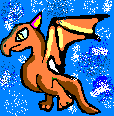- 2 -
A New Spin (Comments cont'd)
'What is
this?'
Add a comment via:
 telejt
telejt[delete_me]@shaw.ca
The
low-barometric pressure caused wind may also bring the big birds, of that time, to finally
come home to roost.
Any attempt to rationalize cold blooded birds, in general, is in trouble.
Birds expend very high energy in the process of flying. It's not likely
that a cold blooded bird could posses the ability to generate the power
required for flying. Big birds, with a wingspan of up to 40 feet (12 m),
are even in a bigger trouble to place.
The pre-historic age biggest animals, of all sorts, can have a
one-to-one correspondence to the big animals alive today. The biggest
plant-eaters correspond to the big elephants. The big predators correspond
to something between the lions and the grizzly bears. However, applying the
same
factor of weight reduction to the big birds would imply that there
should be alive today birds with a wingspan of 15 feet (4.5 m).
Not only those birds don't exist at present, it's unlikely such large birds
could fly at all. It seems to suggest that the large pre-historic birds were
too big even for their own time and their existence can't be explained on the
same basis as the rest of the big animals.

 So what is going on here? Is the whole theory in big trouble? Not, if we
consider the unique winds which were constantly blowing. Anything could
take flight in such a wind provided it had a sufficient wingspan appropriately
oriented for takeoff and maintaining lift. Much like
a '747' flying, with one difference -- the '747' capable of generating
its own wind.
So what is going on here? Is the whole theory in big trouble? Not, if we
consider the unique winds which were constantly blowing. Anything could
take flight in such a wind provided it had a sufficient wingspan appropriately
oriented for takeoff and maintaining lift. Much like
a '747' flying, with one difference -- the '747' capable of generating
its own wind.
It's questionable if these flying animals deserve to be classified as birds
altogether, since they most likely didn't propel themselves by flapping their
wings, but simply relied on the power of the wind to glide. Much like a sailor,
who can travel in any desired direction -- including against the direction of
the wind -- by skillfully deploying and orienting the vessel's sails,
these giant birds could 'fly'
using their elaborate wings (probably,
more of sails than wings) without expending any significant energy
in the process.


"Look Ma! No flapping!"
-- J.T.
------------------------------------------------------------------------------------
----- B. Shipham's comment ------
I like the general gist of it, especially as it has been established
that the earth's spin is still (albeit minutely: approx. 2 seconds every
100,000 years) slowing. There is one thing that I just can't really buy
into: your theory concerning the astronomical body that passed by the
Earth thus slowing its spin is plausible enough, I guess, however, the
fact that it tilted the earth's polar axis is somewhat tricky. After
all, this implies that at some point something else of a similar
magnitude occurred which exerted just enough force to halt this motion
again. Otherwise, why should the earth not still, even if ever so
slightly, be rotating around a lateral axis in addition to its polar
axis? The sun's gravitational pull on the Earth can't be responsible for
a slowing of rotation around an axis that lies - more or less - on the
plane of the earth's orbit. But considering that the Earth is not
rotating around a polar axis that is parallel to that of the sun, then
the direction of the polar shift your theory is based upon implies that
that its axis must lie (at least fairly closely) parallel to the plane
of orbit.
Just a thought... ;)
B. Shipham
The author's response:
One way of looking at that is, indeed, the earth keeps on
rotating around (the old) lateral axis and this rotation is what
constitutes our present earth's spin.
One thing is for sure: it can not spin on one axis and at the same time
rotate also on another. Gyroscopes (of which the earth is one) just don't do that!
The celestial event that caused all of that shifting of spin is rare enough.
To consider another similar event would be too much even for this author,
don't you think?
Nice try, but no cigar.
– J.T.
------------------------------------------------------------------------------------
-------- Matt Weed's comment --------
I enjoyed your article very much.
Could the earlier spin rate be attributed to the earth being much smaller than
it currently is? Similar to a ballerina pulling her arms, and thereby spinning
faster, could an ancient, smaller earth have simply spun more quickly due to
the fact that its mass was closer to the center point? However, would the
centrifugal forces on a smaller globe be cancelled out somewhat due to the
smaller angular size?
I have been reading many articles regarding the "Expanding Earth" theory, with
which I'm certain you're familiar. The theory itself is interesting, and
compelling, but I can't find any explanations to handle why such an expansion
would have occurred so recently (within the last 200 million years or so) and
given the generally acknowledged age of the planet, this would seem to be a
sticking point. I.E. why would the earth stay at a relatively small size for so
long, and then "suddenly" start expanding. Still, while the mechanism might be
unknown currently, it all seems to fit what you're postulating. Perhaps planetary
expansion is a common event in the evolution of planetary systems.
Some potential causative factors:
- A miniature black hole passes by the earth's orbit, and its strong gravitational
effect begins the "thinning out" process of our planet, and thus slowing down the
spin. I really can't see ANYTHING surviving such an event, as it seems the entire
planet would have been resurfaced in magma, but still...
- Moon capture - how long has our moon been in Earth orbit? Given its small mass,
it might not be capable of slowing down the Earth's spin in accordance with your
theories.
- Little green men?
Anyway, great article, well thought out, and I would love to hear your thoughts
if you have a moment.
Take care.
Matt Weed
The author's response:
Could earth, somehow, undergone an expansion which would account for the spin slowing down? If so, how do we account for the likely shift of the spin axis?
-J.T.
------------------------------------------------------------------------------------
----- Peter Steinbach's comment ------
Nice.
I'm still spinning :-)
------------------------------------------------------------------------------------
----- Joe's comment ------
My comment was simply to say that I find the observation that large
dinosaurs would be too heavy to survive interesting. I agree with the
physical basis described in this article.
-Joe
------------------------------------------------------------------------------------
----- Ian Tulloch's comment ------
Thank you for putting New Spin for public
consumption. A very interesting reading ...
Have there been any developments on the subject?
Ian Tulloch, (an interested observer)
------------------------------------------------------------------------------------
Next:
Documented evidence from independent sources.
Contents
i. 'What is this?'
ii. --The short answer:
iii. --The long answer:
iv. For the impatient:
v. 'What is next then?'
1. The
bigger they are ...
2. Is
there a limit to growth?
3. Not
convinced yet? What does rate have to do with it?
4. Why
aren't any such big animals alive today?
5. What,
then, made it possible for them to take their place in the earth's
history?
6.
But aren't weight and size one and the same?
7. Are
we talking change in gravity, then?
8. What
is centrifugal force and how could it affect the weight?
9. What
is it that made earth's spin to slow down?
10. Where is the proof?
11. What is there
left to do?
Acknowledgment.
Comments.
Appendix: documented
evidence from independent sources.
|
